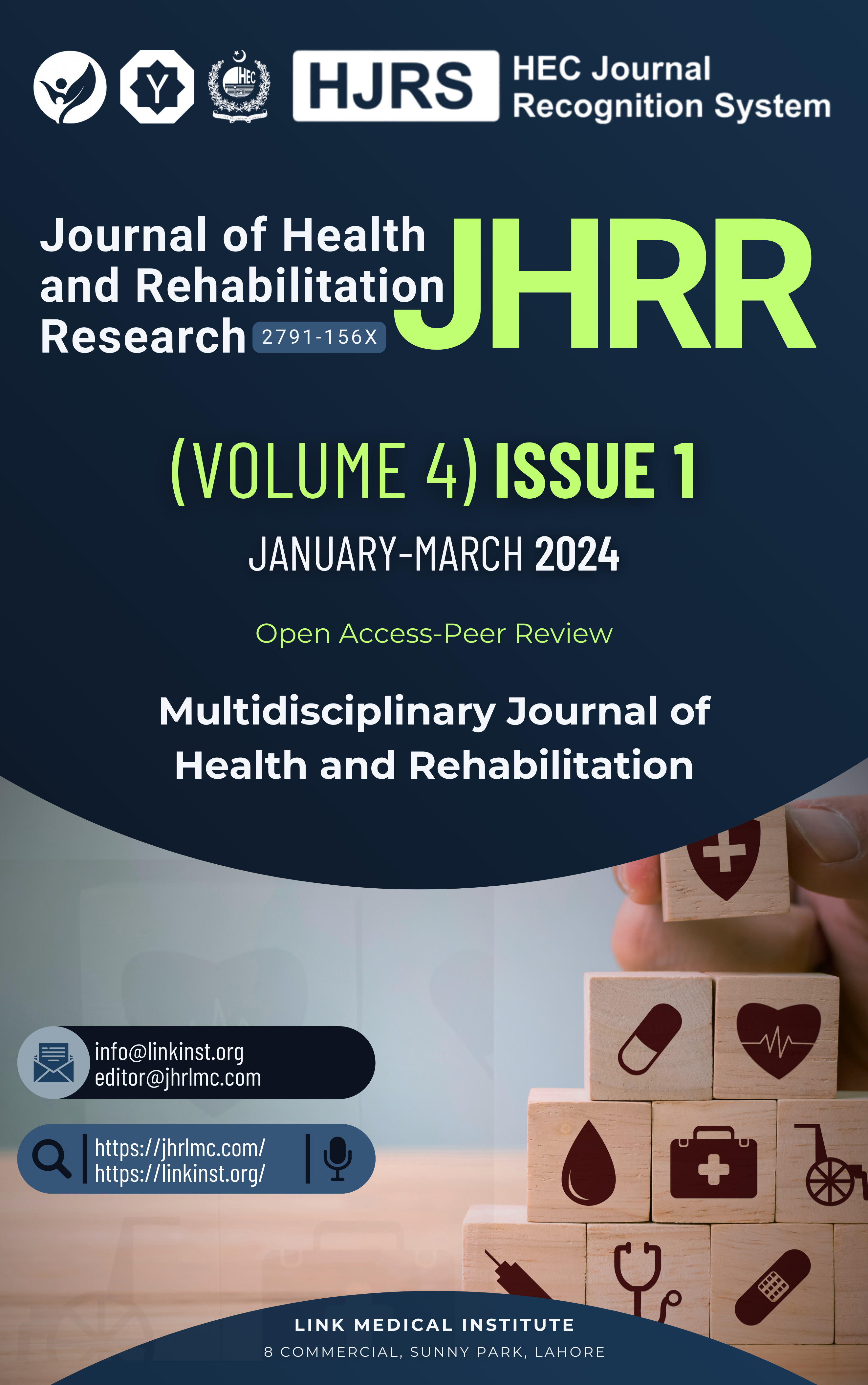The Impact of Aging on the Human Skeletal System
DOI:
https://doi.org/10.61919/jhrr.v4i1.1124Keywords:
Impact, Aging, Human, SkeletalAbstract
Background: Aging significantly affects the human skeletal system, leading to a decline in bone mass, density, and functionality. Conditions such as osteoporosis and arthritis become more prevalent, impacting the quality of life in older adults. This study aimed to investigate the impact of aging on the skeletal system, focusing on bone health, lifestyle factors, and medical interventions.
Objective: The objective of this research was to examine the prevalence of bone-related conditions, lifestyle habits, and the effectiveness of current medical interventions in mitigating the effects of aging on the skeletal system.
Methods: The study was conducted at the Faculty of Rehabilitation Sciences, Lahore University of Biological and Applied Sciences, Pakistan. A total of 47 participants, aged 20 to 84 years, were included. Data were collected through comprehensive questionnaires covering medical history, lifestyle habits, current medications, and menopausal status for female participants. Bone health was assessed through self-reported incidence of bone pain, fractures, and mobility issues, supplemented by medical records and imaging data. Logistic regression analysis was performed using SPSS version 25 to identify associations between bone pain and variables such as fractures, mobility issues, and supplement use.
Results: The study included 47 participants with a mean age of 52.47 years. The prevalence of osteoporosis was 55.3%, arthritis 57.4%, hyperthyroidism 38.3%, hypothyroidism 44.7%, diabetes 51.1%, and cardiovascular disease 59.6%. Smoking and alcohol consumption were reported by 55.3% and 59.6% of participants, respectively. Physical activity levels varied, with 29.8% being super active and 19.1% sedentary. The mean number of medications taken was 2.55. Bone pain was reported by 38.3% of participants, fractures by 46.8%, and mobility issues by 48.9%. Logistic regression indicated possible associations between bone pain and fractures (p=0.172) and mobility issues (p=0.153), while calcium or vitamin D supplements were not significantly associated with bone pain (p=0.823).
Conclusion: The study highlighted the significant impact of aging on the skeletal system, with high prevalence rates of osteoporosis, arthritis, and cardiovascular disease. Lifestyle factors such as smoking, alcohol consumption, and physical activity levels also played crucial roles. Fractures and mobility issues were identified as potential risk factors for bone pain. These findings underscore the need for comprehensive healthcare strategies addressing medical and lifestyle factors to mitigate the effects of aging on the skeletal system and improve the quality of life for older adults.
Keywords: Aging, Skeletal System, Osteoporosis, Arthritis, Bone Health, Lifestyle Factors, Medical Interventions, Bone Pain, Fractures, Mobility Issues, Calcium Supplements, Vitamin D Supplements, SPSS Analysis, Geriatric Health, Preventive Healthcare.
Downloads
References
Cooper C, Javaid MK, Taylor P. The Epidemiology of Osteoporosis. Curr Osteoporos Rep. 2018;16(1):22-30.
Reginster JY, Burlet N. Osteoporosis: A Still Increasing Prevalence. Bone. 2006;38(2):4-9.
Johnell O, Kanis JA. An Estimate of the Worldwide Prevalence, Mortality and Disability Associated With Hip Fracture. Osteoporos Int. 2006;17(2):1726-1733.
Cross M, Smith E, Hoy D, Nolte S, Ackerman I, Fransen M, et al. The Global Burden of Hip and Knee Osteoarthritis: Estimates From the Global Burden of Disease 2010 Study. Ann Rheum Dis. 2014;73(7):1323-1330.
Fukui T, Schneider PB, Harada H, Komatsu M, Hirano Y, Yamamoto K, et al. Bone Mineral Density and Cardiovascular Risk Factors in Elderly Japanese Women. Osteoporos Int. 2011;22(1):274-282.
Kanis JA, Johnell O, Oden A, Johansson H, De Laet C, Eisman JA, et al. Smoking and Fracture Risk: A Meta-Analysis. Osteoporos Int. 2005;16(2):155-162.
Warburton DE, Nicol CW, Bredin SS. Health Benefits of Physical Activity: The Evidence. CMAJ. 2006;174(6):801-809.
Holick MF. Vitamin D Deficiency. N Engl J Med. 2007;357(3):266-281.
Boonen S, Autier P, Barette M, Vanderschueren D, Lips P, Haentjens P. Functional Outcome and Quality of Life Following Hip Fracture in Elderly Women: A Prospective Controlled Study. Osteoporos Int. 2004;15(2):87-94.
Heidari B. Knee Osteoarthritis Prevalence, Risk Factors, Pathogenesis and Features: Part I. Caspian J Intern Med. 2011;2(2):205-212.
Silverman SL, Calderon AD. The Utility and Limitations of FRAX: A US Perspective. Curr Osteoporos Rep. 2010;8(4):192-197.
Raisz LG. Pathogenesis of Osteoporosis: Concepts, Conflicts, and Prospects. J Clin Invest. 2005;115(12):3318-3325.
Eastell R, O'Neill TW, Hofbauer LC, Langdahl B, Reid IR, Gold DT, et al. Postmenopausal Osteoporosis. Nat Rev Dis Primers. 2016;2(1):16069.
Miller PD. Management of Severe Osteoporosis. Expert Opin Pharmacother. 2016;17(4):473-488.
Sowers MR, Greendale GA, Bondarenko IV, Finkelstein JS, Cauley JA, Neer RM. Endogenous Hormones and Bone Turnover Markers in Pre- and Perimenopausal Women: SWAN. Osteoporos Int. 2003;14(3):191-197.
Gielen E, O'Neill TW, Pye SR, Adams JE, Wu FC, Laurent MR, et al. Endocrine Determinants of Incident Sarcopenia in Middle-Aged and Elderly European Men. J Cachexia Sarcopenia Muscle. 2015;6(3):242-252.
Macpherson H, Pipingas A, Pase MP. Multivitamin-Mineral Supplementation and Cognition: A Review of Randomized Controlled Trials. J Alzheimers Dis. 2013;37(4):869-882.
Uusi-Rasi K, Karinkanta S, Kannus P. Is Physical Activity Involved in Maintaining Bone Mass During Growth and Aging? A Review of the Evidence. Calcif Tissue Int. 2013;93(3):241-256.
Anagnostis P, Stevenson JC, Crook D, Johnston DG, Godsland IF. Effects of Menopause, Gender, and Age on Lipids and High-Density Lipoprotein Cholesterol Subfractions. Maturitas. 2015;81(1):62-68.
Compston J, Cooper A, Cooper C, Gittoes N, Gregson C, Harvey N, et al. UK Clinical Guideline for the Prevention and Treatment of Osteoporosis. Arch Osteoporos. 2017;12(1):43
Downloads
Published
How to Cite
Issue
Section
License
Copyright (c) 2024 Syed Asadullah Arslan, Sahar Ijaz, Ibrahim Mohammed, Amir Jameel, Sehar Fatima, Parvin Akbarov Alakbar, Kashif Ali Sultan

This work is licensed under a Creative Commons Attribution 4.0 International License.
Public Licensing Terms
This work is licensed under the Creative Commons Attribution 4.0 International License (CC BY 4.0). Under this license:
- You are free to share (copy and redistribute the material in any medium or format) and adapt (remix, transform, and build upon the material) for any purpose, including commercial use.
- Attribution must be given to the original author(s) and source in a manner that is reasonable and does not imply endorsement.
- No additional restrictions may be applied that conflict with the terms of this license.
For more details, visit: https://creativecommons.org/licenses/by/4.0/.






